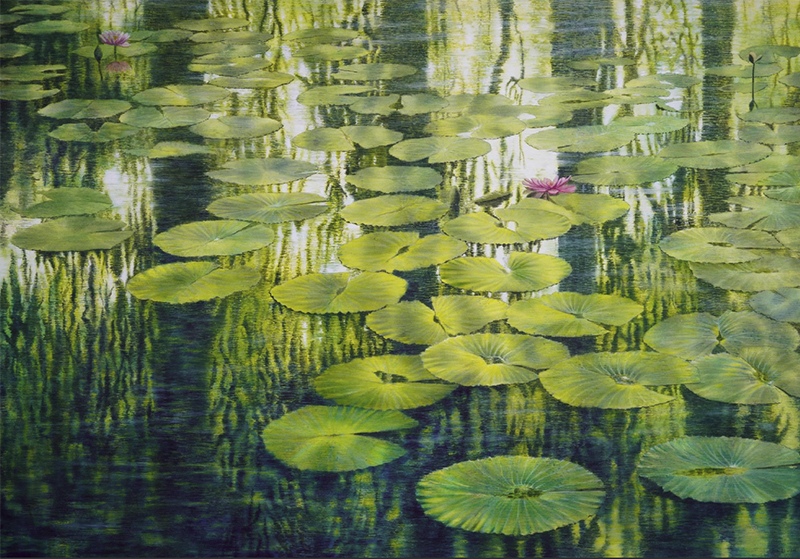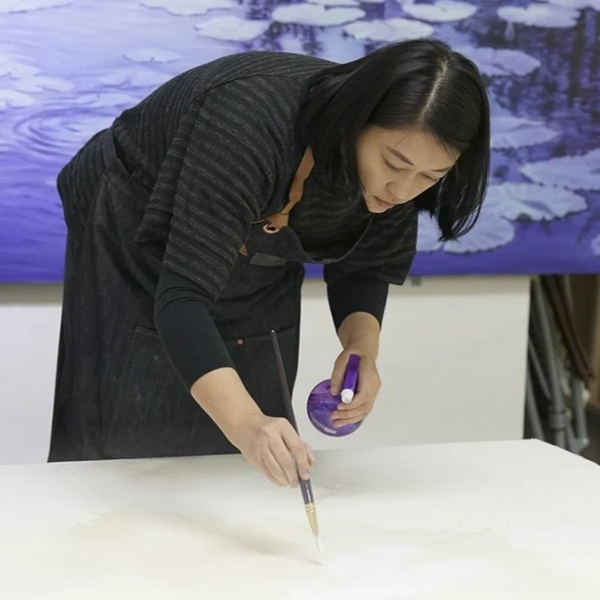
Reflections of the Soul: The Art of Kuo, Hsin-i
Within the tranquil depths of a still pond, a microcosm of the universe unfolds. For Taiwanese artist Kuo, Hsin-i, a pond is both a field of observation and a mirror to the soul. Her masterpiece, Green Dance (137x189cm), not only captures the natural beauty of lily pads adrift like emerald isles and blossoming pink lotuses, but also embodies a philosophical state of “the heart stirs, the water remains still.” Each brushstroke, as she renders ripples, reflections, and the delicate texture of water, becomes a profound dialogue with this miniature cosmos.
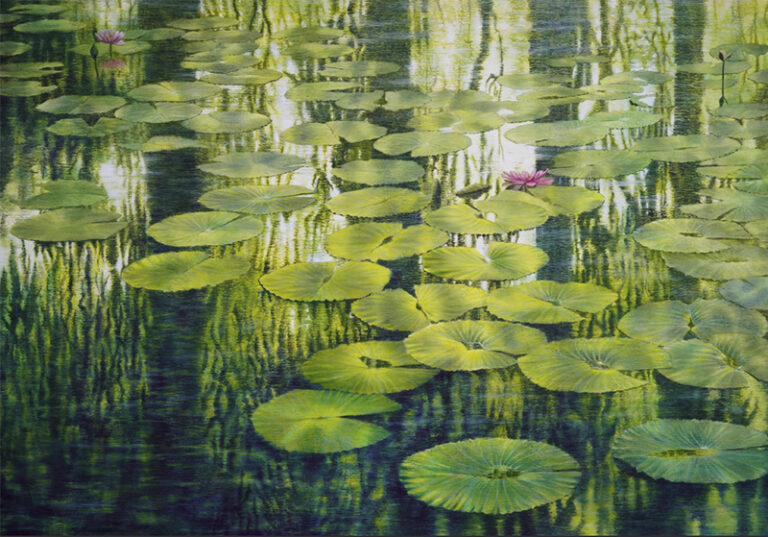
For Kuo, the act of creation is akin to meditative practice. Drawing inspiration from Italo Calvino’s insight that “the soul is always on the surface,” she eschews technical virtuosity, allowing her brush to flow with the rhythm of her inner being. Through her masterful command of watercolor, she transforms the seemingly mundane surface of a pond into a meditation on the cyclical nature of life. In her paintings, water becomes a mirror to the psyche, its shifting colors and forms hinting at inner turbulence and tranquility.
An internationally acclaimed artist, Kuo has garnered prestigious awards, including the First Prize in Watercolor at the Da Dun International Art Exhibition in Taiwan and recognition from the American Watercolor Society. Her works have graced exhibition spaces worldwide, from the grandeur of Taipei 101 to cultural centers in Turkey and Spain. Yet, it is in these seemingly placid portrayals of ponds that we find her most poignant artistic signature. Pigment bleeds into paper like thought itself, creating a visual poem that transcends dimensions, revealing how, through the observation of nature, Kuo transmutes the objective world into an inner landscape of idealized serenity.
Recently, we had the privilege of interviewing Kuo, Hsin-i. Here, she offers captivating insights into her artistic journey, creative process, and how she finds the confluence of the universe and the soul within the confines of a single pond.
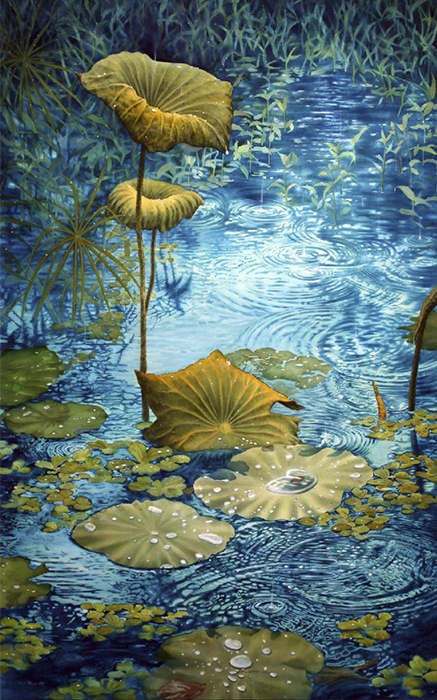
On Creative Philosophy and Visual Language:
Q: How do you translate the philosophical concept of “the water moves, the heart remains still; the heart moves, the water remains still” into a unique visual vocabulary within your work?
A: The phrase “the water moves, the heart remains still; the heart moves, the water remains still” was coined by Taiwanese literary historian Professor Chen Fang-ming after viewing my paintings. For me, a pond is a microcosm of the universe, a convergence of the tangible and intangible, the formed and formless. “I” am both observer and participant, connected to this miniature cosmos, communicating and merging with it through the brush. When I depict the details of water’s movement – the ripples, reflections, and textures – I aim to evoke its life force and fluidity. Perhaps this is what conveys the essence of “the water moves.” The act of painting itself is a meditative process. My compositions often exude a sense of tranquility and stillness. I don’t strive for technical mastery, instead focusing entirely on the present moment, allowing the brush to move organically with the rhythm of my inner being. Perhaps this state of “the heart remains still” is directly reflected in the visual language of my work.
To transcend the three-dimensional reality of a scene and translate it into a higher-dimensional ideal realm requires not only focused concentration and the elimination of distractions during the painting process, but also a continuous elevation of perception. It’s as if I am immersed in the world created within my mind. By observing nature and capturing the fleeting interplay of light and shadow on the water’s surface, I reveal how inner feelings influence the interpretation of the external world. In my paintings, the water’s surface becomes a mirror reflecting the psyche. Through shifts in color and form, it hints at emotional fluctuations and serenity, transforming the objective appearance of nature into an internalized landscape. This, perhaps, is the origin of this philosophical concept.
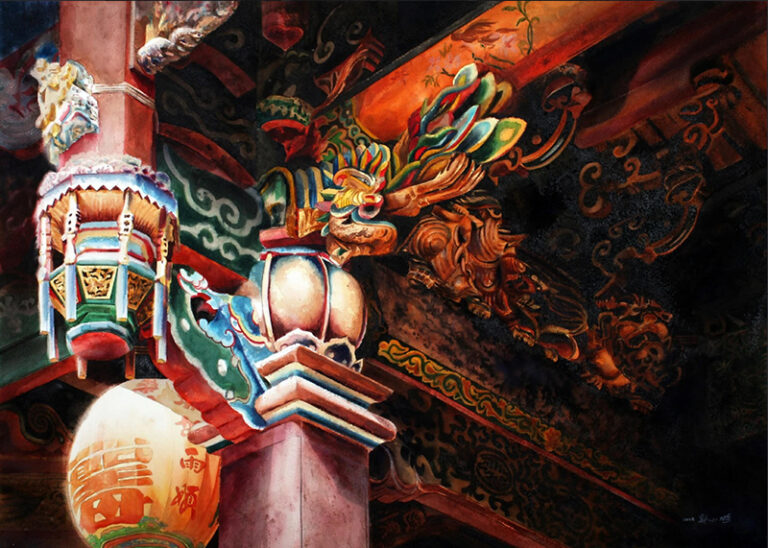
Q: Color plays a vital role in your work. What is the essence and significance of color for you? How does it carry your emotions and thoughts?
A: The world of color is a dimension of immense power and magic. Color can express emotions and feelings, and conversely, it can evoke emotions and feelings in the viewer. For those with normal vision, color has the power to affect our physical and psychological states, even triggering neurological responses. In contemporary life, color theory has become an essential tool, but in the realm of art, the use of color reflects the artist’s consciousness, sensitivity, and even personality. The emotional tension and symbolism of color can directly touch the viewer’s heart, conveying emotions and philosophies that words cannot express.
In the visual logic of most people, the natural world and its various forms and colors are perceived as fixed and inherent. However, exceptional artists utilize color and subject matter to manifest their inner spiritual world, captivating the viewer’s gaze and resonating with their soul. This profound connection is the power of art.
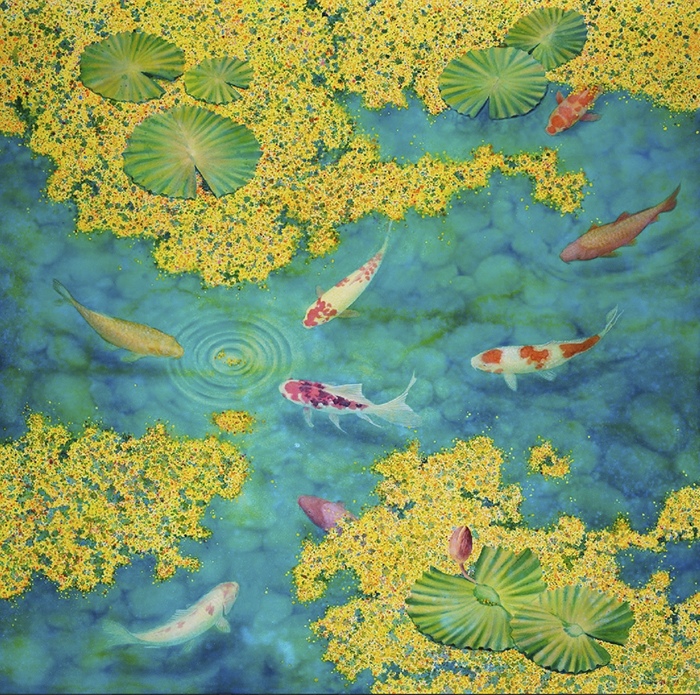
Q: You once said, “Creation is a ritual for healing the soul, a way to communicate with one’s inner self.” In the process of creating the “Pond Series,” how do you break free from the constraints of rational frameworks, allowing your subconscious to naturally integrate into the creative act, ultimately shaping the form of your works?
A: The answer to this question is rather personal and metaphysical, but I will try my best to articulate it. My artistic process is driven by intuition and emotion in the moment rather than by excessive planning or rational analysis. I strive for a state of creative flow, where the brush becomes an extension of my subconscious, capturing fleeting inner feelings and translating them into visual expressions.
Each individual’s life experiences accumulate to form a unique perspective and understanding of the world. Through self-reflection and spiritual exploration, I continually refine my perception of reality. Painting becomes a form of meditation, a way to connect with my inner self and explore the interplay between my internal landscape and the external world reflected in the pond. This freedom to traverse the realms of reality and imagination is perhaps the most valuable gift of an artistic life.
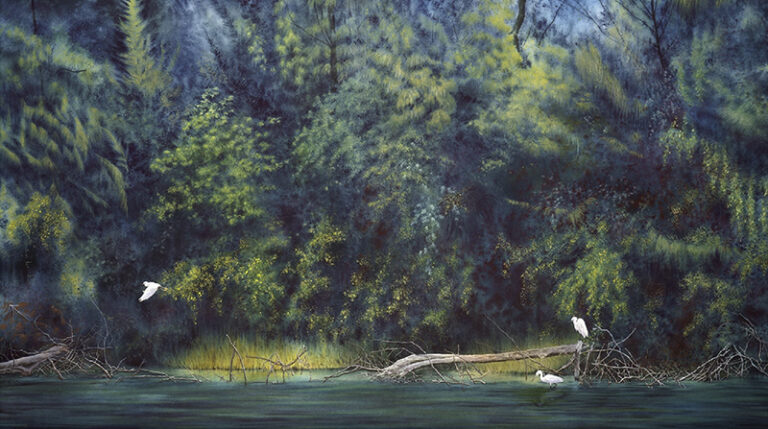
On Technique and Expression:
Q: Watercolor techniques are known for being difficult to master. How do you skillfully capture the fluidity of pigment on canvas, imbuing a static image with such dynamic life force?
A: To say my work possesses a dynamic life force is generous praise, as it is a rather abstract concept. From the outset of my artistic journey, I’ve believed that no medium is inherently superior or more difficult than another. The notion of a medium being “difficult to master” often arises from attempting to replicate a specific technique or emulate the style of a master artist. Frustration in achieving this can lead to the perception that the materials or techniques are challenging, but in reality, it often stems from a lack of familiarity with the chosen medium.
I don’t adhere to any particular technique. Each new work begins with a unique approach and plan. For me, technique is a means to resolve compositional challenges during the creative process, not an end in itself. I am not formally trained in fine arts. I took a few sporadic watercolor classes, but ultimately realized that while technique can be learned, creativity cannot be taught. Creation is an entirely personal experience, a culmination of one’s life. Therefore, the key lies in self-discovery.
To answer your question about “skillfully capturing the fluidity of pigment on canvas,” I can only offer this: strive to expand your consciousness infinitely within the confines of the finite material world. My works have been likened to oil paintings, traditional Asian gouache, and even ink wash paintings. I prefer to describe my approach as using water-based mixed media, as I incorporate any material that works with water. Artistic creation is a process of transforming thought into tangible form, and a deep exploration and understanding of materials lie at the heart of an artist’s creative essence.
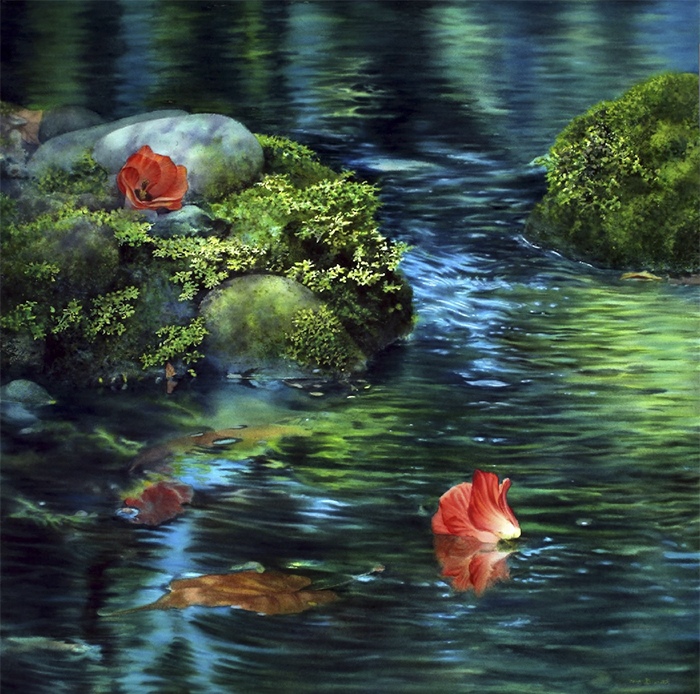
Q: The exquisite interplay of light and shadow with water in your paintings creates a powerful visual impact on the viewer. What creative mindset and emotions lie behind these breathtaking scenes?
A: “All conditioned things are like a dream, an illusion, a bubble, a shadow, like dew or a flash of lightning; thus we should view them.” This verse from the Diamond Sutra illuminates the illusory nature of worldly phenomena. Light and shadow are ephemeral, shifting with time, angle, and environment. As Buddhist teachings suggest, everything in the world arises and passes away due to causes and conditions; attachment is futile. Light and shadow, by their nature, lack a fixed form. They depend on a light source and an object, symbolizing the emptiness of worldly phenomena, devoid of inherent existence or essence. Though fleeting, light and shadow possess profound beauty in the moment of their existence, echoing the Buddhist concept of “the present moment is reality.”
The qualities of water resonate deeply with Buddhist wisdom, particularly in illustrating the impermanence, emptiness, and constant flux of all things. Water serves as a potent symbol. As the Tao Te Ching states, “The highest good is like water. Water benefits all things and does not contend. It dwells in places that all disdain. Therefore, it is close to the Tao.” Through continuous painting and observation of water, I strive to remain close to the Tao. The elements of light, shadow, and water in the Pond Series embody my poetic portrayal of life and the inner world.
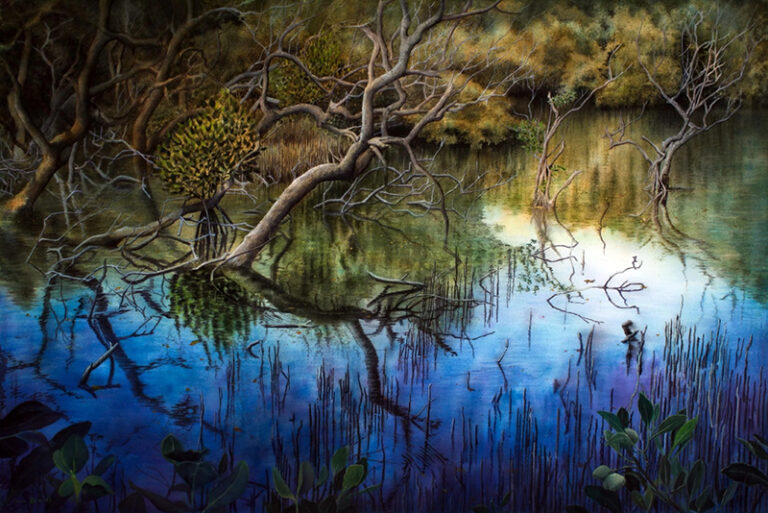
On Depth and Meaning:
Q: In your artist statement, you mention the dialectical relationship between “the metaphysical” and “the physical,” and the notion that “depth is hidden within the surface.” How do you convey your inner spiritual world and philosophical reflections through the tangible landscapes of ponds in your watercolor paintings? How does this mode of expression resonate deeply with viewers?
A: Realism and abstraction, tradition and innovation – these are often presented as opposing concepts for artists. I believe that both are merely expressions of the artist’s perception of the phenomenal world. Realistic imagery can encompass abstract ideas, while abstract works can express profound truths about reality.
The Pond Series represents a stage in my artistic journey where I began seeking deeper spiritual meaning. Through practice and reflection, I arrived at a clearer creative direction and stance. I also wanted to explore new possibilities for figurative representation beyond the familiar styles of Impressionism, Photorealism, or Surrealism.
Renowned Taiwanese art historian Professor Hsiao Chong-jui has described my painting style as “psychological realism”: “Viewing Kuo Hsin-i’s work is like peering into a closed yet vibrant pond, witnessing the pulse of life – water, light, ripples… It is the concrete manifestation of an artist with a delicate soul, her growth and reflections on life.” He likens it to the poetry of Rabindranath Tagore, “seemingly ordinary yet profound: a leaf silently falls there; a small bird comes to the window and flies away.” The most straightforward depiction can evoke the deepest contemplation. Indeed, a small stone can inspire some to contemplate the creation of all things and the vastness of the universe, while others may overlook it or kick it aside.
Therefore, I strive to utilize my talents to the fullest, revealing the inherent beauty and emotional resonance within seemingly mundane subjects. I hope to awaken viewers to the wonders of nature and encourage exploration of their inner worlds, offering moments of tranquility and connection through my art.
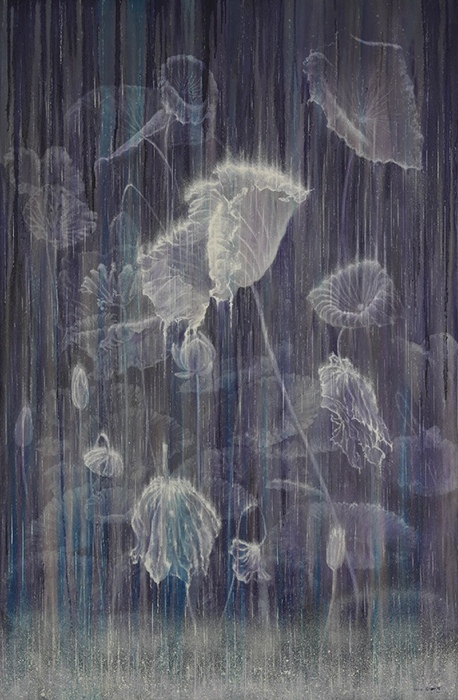
Q: Your works showcase the complete cycle of life, from the blooming to the withering of lotuses, like a visual requiem. Can you elaborate on how you capture and interpret this aesthetic of intertwined life and death in your work, and its profound impact on your artistic philosophy?
A: The natural elements within a pond, through the process of creation, have allowed me to grasp the truths of impermanence and eternity. Reflecting on the cycle of birth and death in the natural world, the limitations of time and space, and the ephemeral nature of life, my yearning for spiritual exploration intensified, giving rise to artistic creation.
In Eastern cultures, the lotus symbolizes purity and transcendence. It has been a subject of artistic celebration since ancient times, depicted not only in its full bloom, but also in its stages of decay and withering. This suggests that although life ends, it does not truly disappear, reflecting the acceptance of impermanence and the yearning for eternity in Eastern philosophy. Life and death are not opposites, but different stages within a cycle.
Nature is the key to understanding the universe and life. The lotuses, light, shadow, and water in the pond have elevated my thinking and perspective, leading me to contemplate human emotions and the essence of life. They are the starting point for my understanding of the Tao.
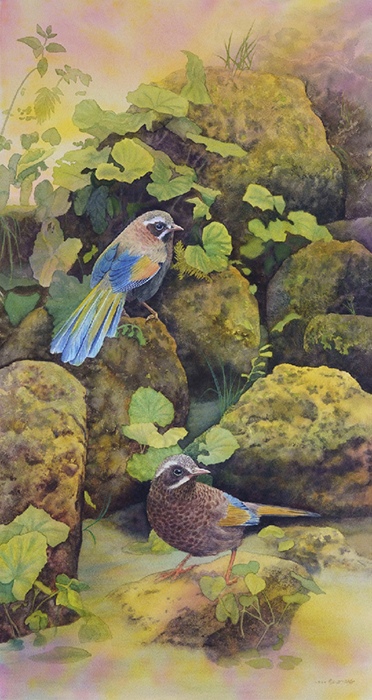
On Artistic Journey and Future Aspirations:
Q: “Discovering the extraordinary within the ordinary, finding profoundness in simplicity” is your long-held creative philosophy. Looking back over the past decade (from 2014 to the present), how has this philosophy evolved and deepened alongside your artistic journey? How have you continued to push your boundaries and transcend existing artistic limitations?
A: An artist’s journey is a process of constant change and growth, encompassing inner emotions, external environment, technical exploration, and the deepening of ideas. This evolution typically unfolds with time, experience, and life’s journey. While others perceive a distinct style in my work, the pursuit of style was never my initial objective. True style cannot be forced; it emerges organically through deep inner exploration, the accumulation of time, and dedicated focus. This ultimately manifests as a personal visual language on the canvas.
I have long focused on ponds as my subject matter, yet each painting possesses a unique character, as if imbued with independent thought and expression, existing in its own world. The question of how to continuously push boundaries and transcend existing artistic limitations cannot be answered with deliberate actions or instant solutions. It requires living authentically and wholeheartedly, expanding one’s horizons and experiences, consistently listening to one’s inner voice, and persistently pursuing growth. Ultimately, everything will transform.
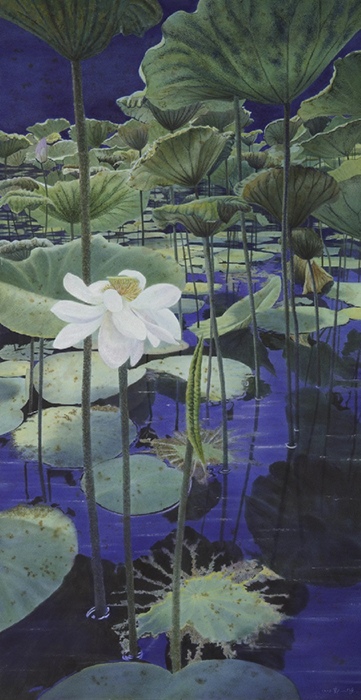
Perspectives and Expectations:
Q: How do you view the status and potential of watercolor as a medium in the contemporary art world?
A: Watercolor, a traditional painting medium, is accessible and easy to learn, making it familiar to almost everyone. However, it has often been regarded as a “secondary” or supplementary medium, long considered less “mainstream” than oil painting or new media art, remaining marginalized in the art market.
Despite this, a growing number of artists are embracing watercolor as their primary creative tool, exploring new forms of expression. At its core, artistic creation transforms intangible thoughts into tangible forms, and the choice of medium is merely a tool to achieve this transformation. I believe watercolor is demonstrating renewed vitality and potential in the contemporary art world. In the midst of contemporary art’s diverse development, watercolor retains its unique characteristics and expressive power. As more and more talented artists push the boundaries of watercolor, it is gaining recognition. I believe that in the near future, watercolor will be redefined as a vital medium with immense creative potential.
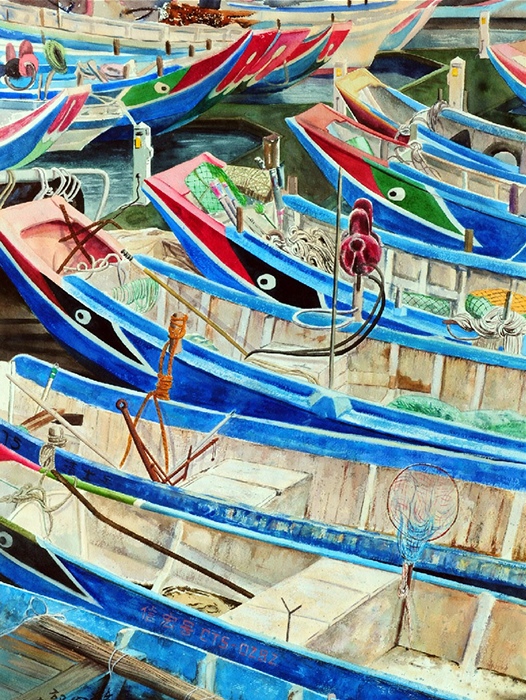
Q: What are your expectations and encouragement for young artists who aspire to pursue their artistic dreams?
A: My own artistic journey is relatively short, beginning in 2009. I am still exploring and can only share the insights I’ve gained along the way:
– The power of art stems from authenticity. When creating, stay true to your inner voice, and your work will be more compelling.
– Focus on the creation itself. Do not be swayed or compromised by external evaluations or the pursuit of success.
– Embrace solitude during the creative process. Solitude fosters reflection and growth, allowing you to develop your own unique voice.
– Art is personal expression and a means of communicating with the world. Touch others with your work and bring beauty into the world.
– The development of style and the maturity of thought cannot be rushed. Allow yourself ample time to settle, explore, and grow.
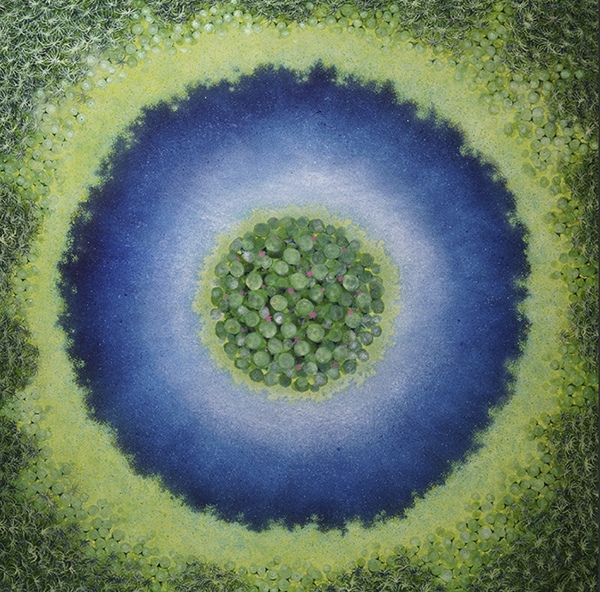
Conclusion:
Through this in-depth conversation with Kuo, Hsin-i, we gain a deeper understanding that her exquisite watercolor paintings not only capture the beauty of nature, but also invite us into a profound dialogue with eternity. Her work reminds us that sometimes the most profound truths are not hidden in the depths, but reside in the subtle interplay between surface and reflection. An ordinary pond becomes a universe imbued with meaning, where the dance of light and shadow on the water illuminates the undercurrents of our consciousness. In Kuo, Hsin-i’s world of lotus flowers and lily pads, bathed in light and shadow, we see more than just aesthetically pleasing paintings. We see a window into the soul of nature, a testament to the enduring power of art to inspire, transform, and illuminate the human experience.
